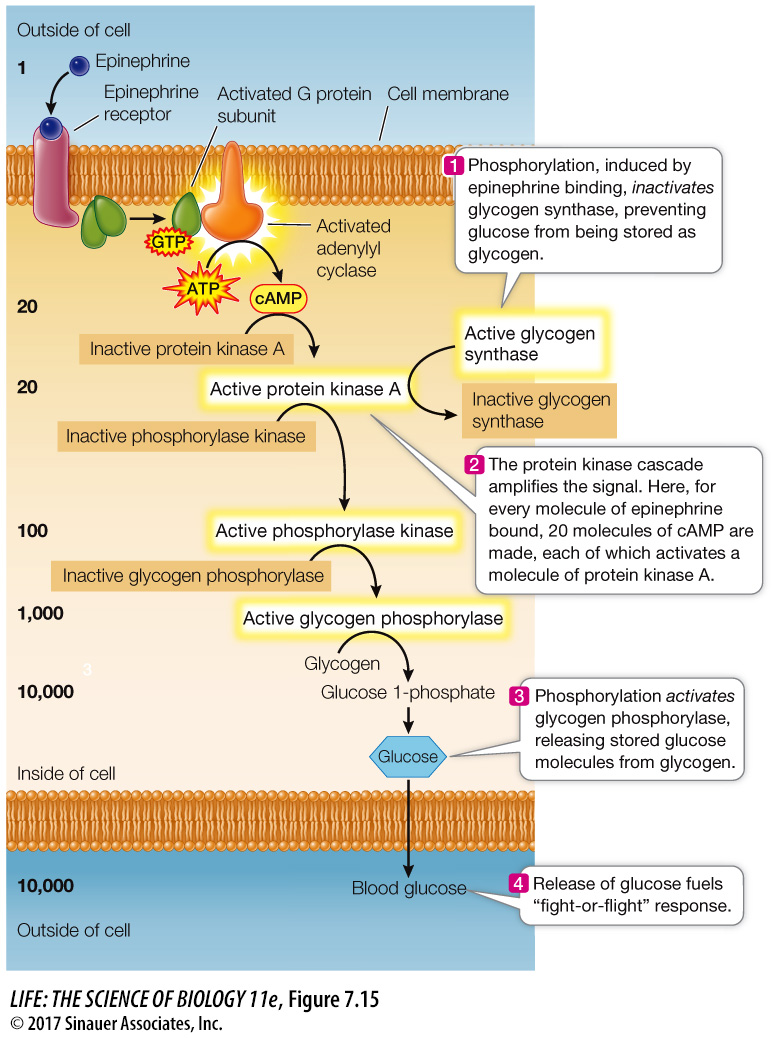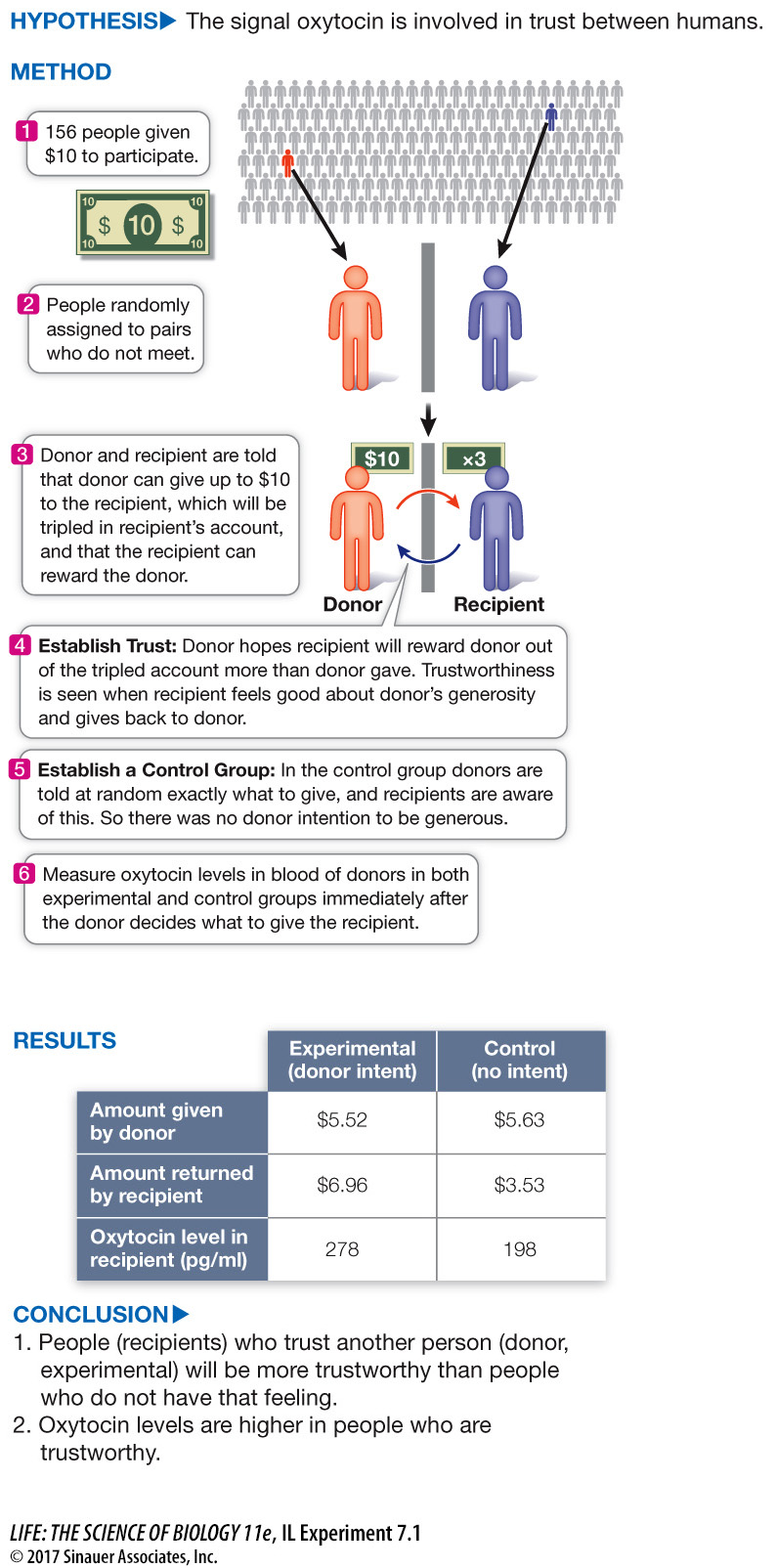Enzyme activities change in response to signals
Enzymes are often modified during signal transduction—
The G protein-
Inhibition: Glycogen synthase, which catalyzes the joining of glucose molecules to synthesize the energy-
storing molecule glycogen, is inactivated when a phosphate group is added to it by protein kinase A. Thus the epinephrine signal prevents glucose from being stored in the form of glycogen (Figure 7.15, step 1). Activation: Phosphorylase kinase is activated when a phosphate group is added to it. It is part of a protein kinase cascade that ultimately leads to the activation of glycogen phosphorylase, another key enzyme in glucose metabolism. This enzyme results in the liberation of glucose molecules from glycogen (Figure 7.15, steps 2 and 3).
*connect the concepts Enzyme regulation determines the rate of chemical transformations in cells, and thus cell functions. See Key Concept 8.5.
The amplification of the signal in this pathway is impressive; as detailed in Figure 7.15, each molecule of epinephrine that arrives at the cell membrane ultimately results in the release of 10,000 molecules of glucose into the bloodstream:
1 molecule of epinephrine bound to the membrane leads to
20 molecules of cAMP, which activate
20 molecules of protein kinase A, which activate
100 molecules of phosphorylase kinase, which activate
1,000 molecules of glycogen phosphorylase, which produce
10,000 molecules of glucose 1-
10,000 molecules of blood glucose
143

Activity 7.2 Cell Signaling and Amplification Simulation
www.life11e.com/
144
investigating life
Is Oxytocin a “Trust” Signal in Humans?
experiment
Original Paper: Zak, P., R. Kurzband and W. T. Matzner. 2005. Oxytocin is associated with human trustworthiness. Hormones and Behavior 48: 522–
Cell signaling in the brain leads to changes in behavior. This experiment investigates whether the peptide oxytocin correlates with the development of trust between humans.

work with the data
Original Paper: Kosfeld, M., M. Heinrichs, P. Zak, U. Fischbaker and E. Fehr. 2005. Oxytocin increases trust in humans. Nature 435: 673–
Paul Zak used an economics experiment to investigate trust and found that when people felt that a stranger had trusted them with money, the recipients not only reciprocated by giving the donor some money back, but also had elevated levels of the intercellular signaling molecule oxytocin. As in many experiments, although these data were suggestive of a relationship, correlation does not necessarily mean causation. So Zak and his colleagues tried a direct experiment in which subjects were given oxytocin before the experiment, to determine if oxytocin induces greater trust.
QUESTIONS
Question 1
In the experiment, donors were divided into control and experimental groups and paired with recipients. All donors were given 12 money units and asked to donate to a paired recipient, whom they did not know or see. Donors knew that whatever amount they donated would be tripled in the recipient’s account (up to 36 units) and trusted that the recipient would generously give some money back to the donor. The experimental donor group was given nasal spray containing oxytocin just before the experiment; the control donor group received a nasal spray without oxytocin. The table shows the results.
| Average number of units (SD) sent to recipient | |
|---|---|
| Experimental group (with oxytocin spray) | 9.6 (2.8) |
| Control (no oxytocin spray) | 8.1 (3.1) |
What can you conclude from these data about oxytocin and trust in the donors? What statistical test would you use to show that the two averages are significantly different?
There was a higher level of trust in the donors who received oxytocin than in those who did not. The difference was about 15 percent. A t-test could be used to assess the difference for statistical significance.
Question 2
The experiment described in Question 1 was repeated, but this time both donor groups were told exactly how much to give the recipient. The results are shown in the table.
| Average number of units (SD) sent to recipient | |
|---|---|
| Experimental group (with oxytocin spray) | 7.5 (3.3) |
| Control (no oxytocin spray) | 7.5 (3.4) |
What can you conclude about the effect of oxytocin in this case, and what does it indicate about the trust relationship?
There was no difference in investment between oxytocin-
A similar work with the data exercise may be assigned in LaunchPad.